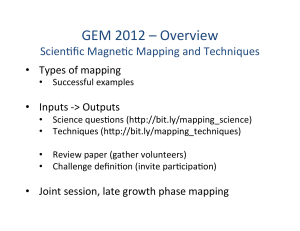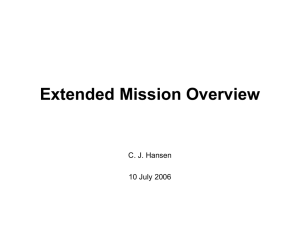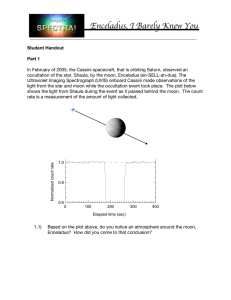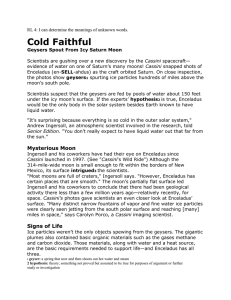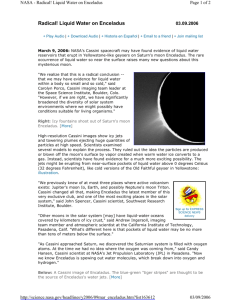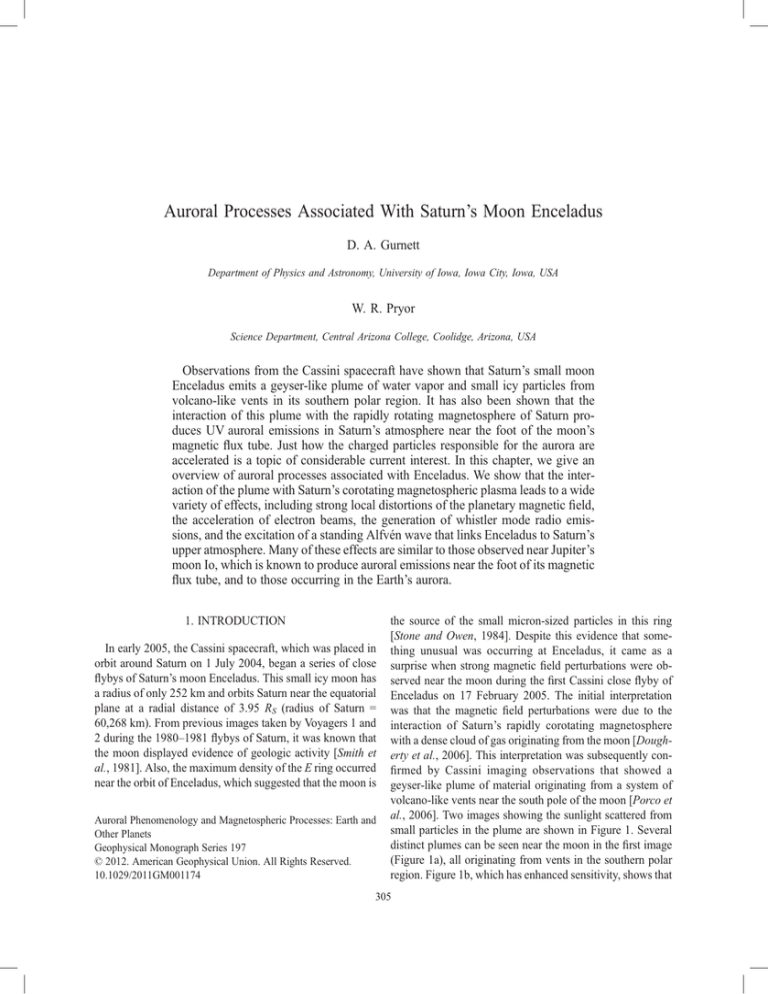
Auroral Processes Associated With Saturn’s Moon Enceladus
D. A. Gurnett
Department of Physics and Astronomy, University of Iowa, Iowa City, Iowa, USA
W. R. Pryor
Science Department, Central Arizona College, Coolidge, Arizona, USA
Observations from the Cassini spacecraft have shown that Saturn’s small moon
Enceladus emits a geyser-like plume of water vapor and small icy particles from
volcano-like vents in its southern polar region. It has also been shown that the
interaction of this plume with the rapidly rotating magnetosphere of Saturn produces UV auroral emissions in Saturn’s atmosphere near the foot of the moon’s
magnetic flux tube. Just how the charged particles responsible for the aurora are
accelerated is a topic of considerable current interest. In this chapter, we give an
overview of auroral processes associated with Enceladus. We show that the interaction of the plume with Saturn’s corotating magnetospheric plasma leads to a wide
variety of effects, including strong local distortions of the planetary magnetic field,
the acceleration of electron beams, the generation of whistler mode radio emissions, and the excitation of a standing Alfvén wave that links Enceladus to Saturn’s
upper atmosphere. Many of these effects are similar to those observed near Jupiter’s
moon Io, which is known to produce auroral emissions near the foot of its magnetic
flux tube, and to those occurring in the Earth’s aurora.
1. INTRODUCTION
In early 2005, the Cassini spacecraft, which was placed in
orbit around Saturn on 1 July 2004, began a series of close
flybys of Saturn’s moon Enceladus. This small icy moon has
a radius of only 252 km and orbits Saturn near the equatorial
plane at a radial distance of 3.95 RS (radius of Saturn =
60,268 km). From previous images taken by Voyagers 1 and
2 during the 1980–1981 flybys of Saturn, it was known that
the moon displayed evidence of geologic activity [Smith et
al., 1981]. Also, the maximum density of the E ring occurred
near the orbit of Enceladus, which suggested that the moon is
Auroral Phenomenology and Magnetospheric Processes: Earth and
Other Planets
Geophysical Monograph Series 197
© 2012. American Geophysical Union. All Rights Reserved.
10.1029/2011GM001174
the source of the small micron-sized particles in this ring
[Stone and Owen, 1984]. Despite this evidence that something unusual was occurring at Enceladus, it came as a
surprise when strong magnetic field perturbations were observed near the moon during the first Cassini close flyby of
Enceladus on 17 February 2005. The initial interpretation
was that the magnetic field perturbations were due to the
interaction of Saturn’s rapidly corotating magnetosphere
with a dense cloud of gas originating from the moon [Dougherty et al., 2006]. This interpretation was subsequently confirmed by Cassini imaging observations that showed a
geyser-like plume of material originating from a system of
volcano-like vents near the south pole of the moon [Porco et
al., 2006]. Two images showing the sunlight scattered from
small particles in the plume are shown in Figure 1. Several
distinct plumes can be seen near the moon in the first image
(Figure 1a), all originating from vents in the southern polar
region. Figure 1b, which has enhanced sensitivity, shows that
305
306
AURORAL PROCESSES ASSOCIATED WITH ENCELADUS
Figure 1. (a) High-phase angle clear-filter images taken by the Cassini Imaging Science Subsystem showing the plume of
material ejected from the southern polar region of Enceladus. From Porco et al. [2006] (http://www.sciencemag.org/
content/311/5766/1393.abstracta). Reprinted with permission from AAAS. (b) An enhanced color-coded version of
Figure 1a.
the plume extends southward over a region that has vertical
and horizontal extents comparable to the size of the moon.
Because of the remarkable processes occurring in and near
Enceladus, the orbit of Cassini was subsequently adjusted to
give a series of passes near and through the plume. UV
absorption features observed in starlight that passed through
the plume and in situ measurements of the small dust particles revealed that the plume is composed primarily of water
vapor and micron and submicron water ice particles [Hansen
et al., 2006; Spahn et al., 2006]. Mass spectrometer measurements showed that, in addition to water vapor, the plume also
contains a wide range of heavier molecules, including complex hydrocarbons [Waite et al., 2011]. Particle and field
measurements showed that the plume has a very strong effect
on the corotating magnetospheric plasma, which streams by
at a nominal approach speed of 26.4 km s 1. These effects
include (1) charge exchange reactions between the neutral
gas in the plume and the corotating magnetospheric ions,
with the attendant acceleration of the newly created pickup
ions to energies of several hundred eV by the corotational
electric field [Tokar et al., 2006], (2) local depletion of
radiation belt particles due to impacts with the moon [Jones
et al., 2006], and (3) strong evidence that charged dust
particles play an important role in the interaction [Spahn et
al., 2006; Farrell et al., 2010; Simon et al., 2011; Kriegel et
al., 2011; Shafiq et al., 2011].
During the Voyager 1 flyby of Jupiter in 1979, it was
discovered that its moon Io has active volcanism and that
the resulting gas cloud around the moon interacts strongly
with Jupiter’s rapidly rotating magnetospheric plasma. Magnetic field measurements made during the Voyager 1 flyby of
Io [Ness et al., 1979; Neubauer, 1980] showed that a standing Alfvén wave (also called an Alfvén wing) is excited by
the moon, thereby confirming a prediction made many years
earlier by Goldreich and Lynden-Bell [1969] to explain Io’s
control of Jupiter’s decametric radio emissions [Bigg, 1964].
Several years later, aurora emissions were observed in Jupiter’s atmosphere near the foot of the Io flux tube [Connerney
et al., 1993; Clarke et al., 1996], further demonstrating the
strength of the Io interaction. The recent discovery of geysers
at Enceladus prompted an intense search for similar effects at
Saturn. Although an initial search for auroral emissions in
Saturn’s atmosphere near the foot of Enceladus’ magnetic
field line was unsuccessful [Wannawichian et al., 2008], a
more extensive search by Pryor et al. [2011] reported clear
evidence of such emissions. Pryor et al. also identified magnetic field-aligned electron beams in the downstream wake of
the moon with sufficient energy flux to drive the auroral
emissions. At about the same time, Gurnett et al. [2011]
reported observations of a standing Alfvén wave excited by
Enceladus and of field-aligned electron beams and radio
emissions originating from the vicinity of the moon. In this
chapter, we give an overview of these and other auroral
processes associated with Enceladus and compare these to
similar processes at Io and in the Earth’s auroral regions.
2. THE AURORA FOOTPRINT OF ENCELADUS
To search for aurora near the foot of Enceladus’ magnetic
flux tube, Pryor et al. [2011] used measurements from the
Cassini Ultraviolet Imaging Spectrometer (UVIS). This instrument provides spectra in both the extreme ultraviolet
(EUV) and the far ultraviolet (FUV) parts of the spectrum.
The EUV and FUV channels have narrow 2 60 and 1.5 60 mrad fields of view. Spatial scans of Saturn’s atmosphere
were obtained by slewing the spacecraft. To provide the best
GURNETT AND PRYOR
opportunity for detecting auroral emissions, the search was
confined to times when Cassini was near periapsis at high
latitudes over the mostly dark northern polar region. Of
approximately 316 UV images of the region near the foot of
Enceladus’ flux tube, only 6 images were found with auroral
spots of the right size and location to be associated with
Enceladus. Two such images, obtained at subspacecraft latitudes from 74° to 65° and radial distances from 8.1 to 6.0 RS,
are shown in Figure 2. Figure 2a was taken from 02:16 to
03:28 UT on 26 August 2008, and Figure 2b was taken about
an hour and a quarter later, from 03:38 to 04:50 UT. The
bright circular emission at about 75° latitude is Saturn’s
auroral oval [Gérard et al., 2004; Grodent et al., 2011]. The
bright spots marked by the white boxes at about 64.5°N
latitude are emissions associated with Enceladus’ flux tube.
The boxes, which have widths of 4° in latitude and 10° in
longitude, are centered on the magnetic field line through the
center of Enceladus using the offset spin-aligned magnetic
dipole model of Burton et al. [2009]. In computing these
boundaries, the altitude of the emission was assumed to be
1100 km, which is the altitude that UV emissions are expected to be generated by auroral electrons impacting Saturn’s mostly molecular hydrogen atmosphere [Gérard et al.,
2009]. As can be seen, the agreement with the predicted
location of the UV emission is very good. The approximately
307
0.9 h shift in the local time of the auroral spot from Figure 1a
to Figure 1b is caused by the orbital motion of Enceladus,
which has a period of 1.37 days. Although the UV emissions
are weaker and occur much less frequently than those associated with Io, these observations provide compelling evidence that Enceladus is exciting auroral emissions near the
foot of its magnetic flux tube.
3. PARTICLE AND FIELD MEASUREMENTS
NEAR ENCELADUS
At the time of this writing (31 October 2011), a total of 16
flybys of Enceladus have been carried out by Cassini. The
flybys are designated E0 through E15. The flyby geometries
are quite varied but primarily consist of two types: (1) passes
obtained on equatorial orbits that are targeted to pass either
upstream or downstream of the moon or, in some cases,
offset to the north or south so as to pass over the poles and
(2) passes on high inclination orbits that are designed to pass
directly through the plume on steeply inclined north/south
trajectories. Since it is not possible to describe all of the
observations, we have decided to discuss two passes, E4 and
E8, which provide a good overview of the observed phenomena. The spacecraft trajectories for these flybys are
shown in Figure 3 using a corotational-aligned coordinate
Figure 2. Two extreme UV images of the northern polar region obtained by the Ultraviolet Imaging Spectrometer on
Cassini, separated by about an hour and a quarter on 26 August 2008. Reprinted by permission from Macmillan Publishers
Ltd: Nature [Pryor et al., 2011], copyright 2011.
308
AURORAL PROCESSES ASSOCIATED WITH ENCELADUS
Figure 3. Spacecraft trajectories in an Enceladus-centered corotationally aligned coordinate system for the E4 and E8 flybys. The z
axis is parallel to Saturn’s rotational axis, the +x axis is in the
direction of the nominal corotational plasma flow, and the +y axis,
which is directed toward Saturn, completes the right-hand coordinate system.
system centered on the moon. One reason for selecting these
two passes is that the field of view of the electron spectrometer (ELS), which is part of the Cassini plasma spectrometer
(CAPS), was aligned nearly along the magnetic field direction. This orientation is desirable because field-aligned electron beams are expected to be the most likely source of the
aurora at the foot of the magnetic field line. Very few flybys
have this favorable orientation.
3.1. E4 Flyby
An overview of the particle and fields measurements obtained during the E4 flyby is shown in Figure 4. We start by
discussing the electric field intensities detected by the radio
and plasma wave science (RPWS) instrument. These are
shown in Figure 4a, which gives a color-coded representation of the electric field intensities as a function of frequency
and time. Although the RPWS instrument was designed to
detect radio and plasma waves, the intense noise on the right
side of the spectrogram is caused by dust particles striking
the spacecraft. Because the spacecraft is moving at a very
high velocity, ~17 km s 1, relative to Enceladus (and to the
dust particles), when a small particle strikes the spacecraft, it
is instantly vaporized and ionized, thereby causing a rapidly
expanding cloud of hot electrons that produces a voltage
pulse on the RPWS electric antenna. A sample voltage pulse
is shown by the small plot inserted in the spectrogram. The
particle size threshold for detecting such impacts is believed
to be a few microns. By counting the voltage pulses, the
impact rate can be determined. Around the time of peak
intensity (red in the spectrogram), roughly 21:06 to 21:08
UT, the impact rate is approximately 1300 impacts per second. As can be seen from the arrow marked “north-to-south
equator crossing,” the highest intensities occur in the region
just south of the equator, consistent with passage through the
plume as determined from optical observations. It is interesting to note that there is still a significant level of impulsive
dust impact noise as early as 21:00 UT, more than 20 RS
north of the moon. Although most of the dust is concentrated
in the plume, some dust is observed over a very large region
around the moon.
Next, we describe the plasma and magnetic field measurements obtained during the E4 flyby. An energy-time spectrogram of the electron count rate detected by the CAPS ELS is
shown in Figure 4b. The corresponding pitch angles detected
by the ELS are shown in Figure 4c. These are generally less
than about 20° to 30°, i.e., nearly field-aligned. As can be
seen, very intense electron fluxes are present during the
approach to the moon, from about 20:54 to 21:05 UT. From
the spacecraft trajectory in Figure 3 and noting that the
magnetic field is almost directly southward (see Figure 4d),
one can see that the electron fluxes are occurring along
magnetic field lines that pass through the downstream wake
region. The electron energy spectrum has a bimodal distribution, with an intense narrow peak at about 1 keV, and a
broader peak at about 10 eV. Both have substantial temporal
variations. Since the spacecraft is north of the moon and the
magnetic field is directed toward the south, the pitch angles
are such that the electrons are moving upward toward the
moon. The magnetic field measurements in Figure 4d show
that large magnetic field disturbances are present in the
region where the intense electron fluxes are observed, especially in the Bx component. A negative ΔBx disturbance
relative to the magnetic field model (shown by the dashed
lines) is indicative of a magnetic field line that is draped
around the moon due to mass loading, as discussed by
Dougherty et al. [2006]. There are two regions with such a
draped field configuration, the first indicated by the small
negative ΔBx disturbance from about 20:56:00 to 20:58:30
UT, nearly 20 RE downstream of the moon, and the second
indicated by the larger negative ΔBx disturbance from about
21:04:30 to 21:07:00 UT, immediately downstream of the
moon. In between these two disturbances, ΔBx is positive,
indicating an antidraped magnetic field. Just what causes
these relatively large downstream magnetic field fluctuations
GURNETT AND PRYOR
309
Figure 4. An overview of measurements obtained during the E4 flyby on 11 August 2008. (a) A frequency-time
spectrogram of the electric field intensity detected by the radio and plasma wave science (RPWS) instrument. (b) An
energy-time spectrogram of the electron count rate from the Cassini plasma spectrometer (CAP) electron spectrometer
(ELS) and (c) The corresponding pitch angles. (d) A plot of the magnetic field components measured by the magnetometer
(MAG).
is not known for certain. Pryor et al. [2011] suggested that
they may be caused by Alfvén waves that are reflecting back
and forth between the two hemispheres in the downstream
region. However, they are also reminiscent of a downstream
flow instability, such as the Kármán vortex street commonly
seen downstream of a cylindrical object in a hydrodynamic
flow.
3.2. E8 Flyby
An overview of the E8 particle and field measurements is
shown in Figure 5, using the same basic format as in Figure 4. In sharp contrast to the E4 flyby, Figure 5a shows that
there is relatively little evidence of dust impacts in the
electric field spectrogram. This is because the E8 flyby is a
relatively distant flyby, passing over the south pole of the
moon at a radial distance of 7.2 RS (see Figure 3). Although
there are relatively few dust impacts, a very clearly defined
V-shaped radio emission can be seen that has its apex centered almost exactly on the time of closest approach. This
type of radio emission is commonly observed over the terrestrial auroral zones and is called “auroral hiss” because of
its close association with the aurora [see Gurnett, 1966;
Gurnett et al., 1983]. The V-shaped frequency-time characteristic is a propagation effect that arises for whistler mode
waves propagating at wave normal angles near the resonance
310
AURORAL PROCESSES ASSOCIATED WITH ENCELADUS
Figure 5. An overview of measurements obtained during the E8 flyby on 21 November 2009 using the format shown in
Figure 4. (a) A frequency-time spectrogram of the electric field intensity detected by RPWS. (b) An energy-time
spectrogram of the electron count rate from the CAP ELS and (c) the corresponding pitch angles. (d) A plot of the
magnetic field components measured by the MAG. From Gurnett et al. [2011].
cone [Mosier and Gurnett, 1969; James, 1976]. It is well
established that terrestrial auroral hiss is generated by fieldaligned electron beams with energies ranging from a few tens
of eV to several keV [Ergun et al., 2003]. Indeed, the energytime spectrogram in Figure 5b shows that two field-aligned
electron beams are observed in the ELS data near the apex of
the V-shaped emission. The magnetic field data in Figure 5d
also show that two large oppositely directed ramp-like magnetic field disturbances occur in this same region. These
ramp-like magnetic field variations are clearly indicative of
field-aligned currents, first southward, from about 02:09:45
to 02:09:58 UT, followed almost immediately by a northward current, from 02:09:58 to 02:10:32 UT. This combination of two oppositely directed currents on a size scale
comparable to the diameter of the moon provides strong
evidence that the spacecraft passed directly through a
shear-mode Alfvén wave excited by the moon. For a further
discussion of the Alfvén wave interpretation, see Gurnett et
al. [2011].
Studies of auroral hiss on Earth show that the emission is
produced by an electron beam-plasma interaction [Maggs,
1976] at the Landau resonance velocity, v‖ = ω/k‖. Terrestrial
studies also show that auroral hiss can be used as a remote
sensing tool to determine where the electron beam is accelerated [Mosier and Gurnett, 1969; James, 1976; Ergun et al.,
2003]. This technique relies on the fact that for whistler
mode propagation near the resonance cone, the wave energy
propagates at a known angle to the magnetic field. For the
GURNETT AND PRYOR
plasma parameters that exist near Enceladus, where the electron cyclotron frequency is much less than the electron
plasma frequency, fc « fp, the angle of the ray path, ψ, relative
to the magnetic field is given by the simple equation, sin ψ =
f/fc, where f is the wave frequency. From this equation, one
can see that the radiation from a point source is beamed along
a cone-shaped surface, the opening angle of which increases
with increasing frequency. It is this frequency dependence
that gives the auroral hiss its characteristic V-shaped frequencytime dependence, first decreasing in frequency as the spacecraft approaches the magnetic field line through the source
and then increasing as the spacecraft moves away. Since the
magnetic field is known to a very good approximation in the
region around the moon, it is a straightforward procedure to
determine a source position that gives a good fit to the Vshaped frequency-time spectrum. Figure 6 shows the results
of such a fitting procedure. Figure 6a shows the ray paths
that give the best fits to the inbound and outbound branches
of the V-shaped emission, and Figure 6b shows the quality
of the fits, which are very good. The y′ axis used in this
analysis passes through the center of the moon and is
Figure 6. (a) Best-fit ray paths for the inbound and outbound
branches of the V-shaped auroral hiss emission in Figure 5a and
(b) corresponding best fits to the outer envelopes of the auroral hiss
spectrum. From Gurnett et al. [2011].
311
parallel to the trajectory in the x,y plane [see Gurnett et al.,
2011]. As can be seen, both the inbound and outbound
sources are located very close to the moon, slightly south
and slightly downstream, consistent with a source in or very
near the plume.
4. DISCUSSION
We have described Cassini observations of aurora at the
foot of the Enceladus flux tube and particle and field measurements from two close flybys of the moon that are relevant to the processes responsible for producing the aurora.
The E4 flyby, which was on magnetic field lines that intersected the downstream wake, showed very intense fieldaligned electron beams with energies ranging from about
10 eV to 1 keV. The beams, which are highly variable, extend
over a considerable region downstream of the moon with
peak energy fluxes of 1 to 2 mW m 2. The field of view of
the electron detector was such that it only detected electrons
moving up the magnetic field line toward the moon, with no
measurements in the opposite direction. Therefore, it is not
clear whether the electrons are being accelerated toward the
moon by some acceleration process farther down the field
line near Saturn or whether they consist of magnetically
reflected bidirectional beams accelerated near the moon,
such as those observed by Williams et al. [1996] downstream
of Io. In contrast, the E8 flyby, which was a distant pass over
the south pole of the moon, clearly showed two field-aligned
electron beams arriving from the moon. Whistler mode auroral hiss was also observed during this pass that is almost
certainly generated by these beams. Ray path analyses of the
auroral hiss showed that the source of these emissions, and
by inference, the region where the electron beams are being
accelerated, was located very close to the moon, probably in
or near the plume. For a further discussion see the work of
Gurnett et al. [2011]. Although models of the plasma interaction by Saur et al. [2007], Wannawichian et al. [2008],
Kriegel et al. [2009], Jia et al. [2010], and others had
suggested that an Alfvén wave might be excited by the
interaction of the corotating plasma with the moon, the E8
flyby, for the first time, clearly showed that a standing Alfvén
wave is, in fact, generated by Enceladus. Whether the electron beams are directly related to the Alfvén wave is not
clear. The beam observed from 02:10:05 to 02:10:40 UT is in
the correct location and direction to carry the northward
current associated with the Alfvén wave. However, the relationship of the other beam, from 02:09:30 to 02:09:45 UT, to
the Alfvén wave is not so clear, since it occurs in a region
where there appears to be little or no current.
Although electron beams with significant energies and
intensities have been observed in the vicinity of Enceladus,
312
AURORAL PROCESSES ASSOCIATED WITH ENCELADUS
it is not yet clear how they are accelerated or whether they are
able to reach Saturn’s atmosphere with enough energy to
produce the observed aurora intensities. In fact, since the
beams observed during the E4 and E8 flybys were in substantially different locations relative to the moon (downstream versus near the flux tube through the moon), it is
not clear that the acceleration mechanisms are even related.
For the intense beams observed moving upward on the
downstream magnetic field lines during the E4 flyby, it is
not known whether they can reach Saturn’s atmosphere even
if they have a bidirectional distribution. Although the beams
were described as “field-aligned” by Pryor et al. [2011], the
atmospheric loss cone has an angle of only 6°. Since the
angular resolution of the measurements is only about 15° to
20° (see Figure 4c), one cannot be certain that a sufficient
fraction of the observed energy flux, ~1 to 2 mW m 2, can
actually reach the foot of the field line to produce the observed aurora. For the beams observed in association with
the standing Alfvén wave during the E8 flyby, there are
similar uncertainties. The ray path studies of the auroral hiss
observed during the E8 flyby strongly indicate that these
beams are accelerated very close to Enceladus, probably in
or near the plume. Since the beams observed during the E8
flyby are considerably less energetic than those observed
during the E4 flyby, it is doubtful that they have enough
energy to produce the aurora. We can only speculate how the
electrons observed during the E8 flyby are accelerated. Possible acceleration mechanisms might include (1) electron
inertial or kinetic effects associated with the Alfvén wave
[Lysak and Song, 2003; Watt and Rankin, 2008], (2) parallel
electric fields [Knight, 1973] that develop in the Alfvén wave
current system, or (3) electrical effects produced by charged
dust in the plume [Kriegel et al., 2011; Morooka et al., 2011].
In considering the origin of the aurora, one must also consider the electromagnetic energy flux carried by the Alfvén
wave. For the observed amplitude of the magnetic field
perturbation associated with the Alfvén wave, ΔB ~ 12 nT,
and the nominal plasma parameters observed during the E8
flyby (B0 = 325 nT, n = 47 cm 3, ion mass ~ 18 amu), the
wave energy flux at the foot of the magnetic field line is
estimated to be about 4 mW m 2, which is quite significant,
greater than the energy flux of the electron beams observed
during the E4 flyby. This Alfvén wave energy could very
well be converted to electron beam energy as the wave
propagates downward and interacts with Saturn’s ionosphere. For a discussion of possible processes for converting
the Alfvén wave energy to field-aligned electron beams, see
the work of Hess et al. [2011].
Acknowledgments. The research at the University of Iowa was
supported by JPL contract 1415150 and the research at Central
Arizona College was supported by the college, by a JPL Cassini
subcontract to LASP/University of Colorado, and by a Cassini Data
Analysis Program grant to Space Environment Technologies.
REFERENCES
Bigg, E. K. (1964), Influence of the satellite Io on Jupiter’s decametric emission, Nature, 203, 1008–1010, doi:10.1038/
2031008a0.
Burton, M. E., M. K. Dougherty, and C. T. Russell (2009), Model of
Saturn’s internal planetary magnetic field based on Cassini observations, Planet. Space Sci., 57, 1706–1713, doi:10.1016/j.pss.
2009.04.008.
Clarke, J. T., et al. (1996), Far-ultraviolet imaging of Jupiter’s
aurora and the Io footprint, Science, 274, 404–409, doi:10.
1126/science.274.5286.404.
Connerney, J. E. P., R. L. Baron, T. Satoh, and T. Owen (1993),
Images of excited H3+ at the foot of the Io flux tube in Jupiter’s
atmosphere, Science, 262, 1035–1038, doi:10.1126/science.262.
5136.1035.
Dougherty, M. K., K. K. Khurana, F. M. Neubauer, C. T. Russell,
J. Saur, J. S. Leisner, and M. E. Burton (2006), Identification of a
dynamic atmosphere at Enceladus with the Cassini magnetometer, Science, 311, 1406–1409, doi:10.1126/science.1120985.
Ergun, R. E., C. W. Carlson, J. P. McFadden, R. J. Strangeway,
M. V. Goldman, and D. L. Newman (2003), Fast auroral snapshot
satellite observations of very low frequency saucers, Phys.Plasmas, 10, 454–462, doi:10.1063/1.1530160.
Farrell, W. M., W. S. Kurth, R. L. Tokar, J.-E. Wahlund, D. A.
Gurnett, Z. Wang, R. J. MacDowall, M. W. Morooka, R. E.
Johnson, and J. H. Waite Jr. (2010), Modification of the plasma
in the near-vicinity of Enceladus by the enveloping dust, Geophys. Res. Lett., 37, L20202, doi:10.1029/2010GL044768.
Gérard, J.-C., D. Grodent, J. Gustin, A. Saglam, J. T. Clarke, and
J. T. Trauger (2004), Characteristics of Saturn’s FUV aurora
observed with the Space Telescope Imaging Spectrograph,
J. Geophys. Res., 109, A09207, doi:10.1029/2004JA010513.
Gérard, J.-C., B. Bonfond, J. Gustin, D. Grodent, J. T. Clarke, D.
Bisikalo, and V. Shematovich (2009), Altitude of Saturn’s aurora and its implications for the characteristic energy of precipitated electrons, Geophys. Res. Lett., 36, L02202, doi:10.1029/
2008GL036554.
Goldreich, P., and D. Lynden-Bell (1969), Io, a Jovian unipolar
inductor, Astrophys. J., 156, 59–78, doi:10.1086/149947.
Grodent, D., J. Gustin, J.-C. Gérard, A. Radioti, B. Bonfond, and
W. R. Pryor (2011), Small-scale structures in Saturn’s ultraviolet
aurora, J. Geophys. Res., 116, A09225, doi:10.1029/2011JA
016818.
Gurnett, D. A. (1966), A satellite study of VLF hiss, J. Geophys.
Res., 71(23), 5599–5615, doi:10.1029/JZ071i023p05599.
Gurnett, D. A., S. D. Shawhan, and R. R. Shaw (1983), Auroral
hiss, Z mode radiation, and auroral kilometric radiation in the
polar magnetosphere: DE 1 observations, J. Geophys. Res.,
88(A1), 329–340, doi:10.1029/JA088iA01p00329.
GURNETT AND PRYOR
Gurnett, D. A., et al. (2011), Auroral hiss, electron beams and
standing Alfvén wave currents near Saturn’s moon Enceladus,
Geophys. Res. Lett., 38, L06102, doi:10.1029/2011GL046854.
Hansen, C. J., L. Esposito, A. I. F. Stewart, J. Colwell, A. Hendrix, W.
Pryor, D. Shemansky, and R. West (2006), Enceladus’ water vapor
plume, Science, 311, 1422–1425, doi:10.1126/science.1121254.
Hess, S. L. G., P. A. Delamere, V. Dols, and L. C. Ray (2011),
Comparative study of the power transferred from satellitemagnetosphere interactions to auroral emissions, J. Geophys.
Res., 116, A01202, doi:10.1029/2010JA015807.
James, H. G. (1976), VLF saucers, J. Geophys. Res., 81(4), 501–514.
Jia, Y.-D., C. T. Russell, K. K. Khurana, G. Toth, J. S. Leisner, and
T. I. Gombosi (2010), Interaction of Saturn’s magnetosphere
and its moons: 1. Interaction between corotating plasma and
standard obstacles, J. Geophys. Res., 115, A04214, doi:10.1029/
2009JA014630.
Jones, G. H., E. Roussos, N. Krupp, C. Paranicas, J. Woch, A.
Lagg, D. G. Mitchell, S. M. Krimigis, and M. K. Dougherty
(2006), Enceladus’ varying imprint on the magnetosphere of
Saturn, Science, 311, 1412–1415, doi:10.1126/science.1121011.
Knight, S. (1973), Parallel electric fields, Planet. Space Sci., 21,
741–750, doi:10.1016/0032-0633(73)90093-7.
Kriegel, H., S. Simon, J. Müller, U. Motschmann, J. Saur, K.-H.
Glassmeier, and M. K. Dougherty (2009), The plasma interaction
of Enceladus: 3D hybrid simulations and comparison with Cassini MAG data, Planet. Space Sci., 57, 2113–2122, doi:10.1016/
j.pss.2009.09.025.
Kriegel, H., S. Simon, U. Motschmann, J. Saur, F. M. Neubauer,
A. M. Persoon, M. K. Dougherty, and D. A. Gurnett (2011),
Influence of negatively charged plume grains on the structure of
Enceladus’ Alfvén wings: Hybrid simulations versus Cassini
Magnetometer data, J. Geophys. Res., 116, A10223, doi:10.
1029/2011JA016842.
Lysak, R. L., and Y. Song (2003), Kinetic theory of the Alfvén wave
acceleration of auroral electrons, J. Geophys. Res., 108(A4),
8005, doi:10.1029/2002JA009406.
Maggs, J. E. (1976), Coherent generation of VLF hiss, J. Geophys.
Res., 81(10), 1707–1724.
Morooka, M. W., J.-E. Wahlund, A. I. Eriksson, W. M. Farrell, D. A.
Gurnett, W. S. Kurth, A. M. Persoon, M. Shafiq, M. André, and
M. K. G. Holmberg (2011), Dusty plasma in the vicinity of
Enceladus, J. Geophys. Res., 116, A12221, doi:10.1029/2011JA
017038
Mosier, S. R., and D. A. Gurnett (1969), VLF measurements of the
Poynting flux along the geomagnetic field with the Injun 5
satellite, J. Geophys. Res., 74(24), 5675–5687, doi:10.1029/JA
074i024p05675.
Ness, N. F., M. H. Acuna, R. P. Lepping, L. F. Burlaga, K. W.
Behannon, and F. M. Neubauer (1979), Magnetic field studies at
Jupiter with Voyager 1: Preliminary results, Science, 204, 982–
987, doi:10.1126/science.206.4421.966.
Neubauer, F. M. (1980), Nonlinear standing Alfvén wave current
system at Io: Theory, J. Geophys. Res., 85(A3), 1171–1178,
doi:10.1029/JA085iA03p01171.
313
Porco, C. C., et al. (2006), Cassini observes the active south pole of
Enceladus, Science, 311, 1393–1401, doi:10.1126/science.
1123013.
Pryor, W. R., et al. (2011), The Enceladus auroral footprint at
Saturn, Nature, 472, 331–333, doi:10.1038/nature09928.
Saur, J., F. M. Neubauer, and N. Schilling (2007), Hemisphere
coupling in Enceladus’ asymmetric plasma interaction, J. Geophys. Res., 112, A11209, doi:10.1029/2007JA012479.
Shafiq, M., J.-E. Wahlund, M. W. Morooka, W. S. Kurth, and W. M.
Farrell (2011), Characteristics of the dust-plasma interaction near
Enceladus’ south pole, Planet. Space Sci., 59, 17–25, doi:10.
1016/j.pss.2010.10.006.
Simon, S., J. Saur, H. Kriegel, F. M. Neubauer, U. Motschmann,
and M. K. Dougherty (2011), Influence of negatively charged
plume grains and hemisphere coupling currents on the structure
of Enceladus’ Alfvén wings: Analytical modeling of Cassini
magnetometer observations, J. Geophys. Res., 116, A04221,
doi:10.1029/2010JA016338.
Smith, B. A., et al. (1981), Encounter with Saturn: Voyager 1
imaging science results, Science, 212, 163–191, doi:10.1126/
science.212.4491.163.
Spahn, F., et al. (2006), Cassini dust measurements at Enceladus
and implications for the origin of the E-ring, Science, 311, 1416,
doi:10.1126/science.1121375.
Stone, E. C., and T. C. Owen (1984), The Saturn system, in Saturn,
edited by T. Gehrels and M. S. Matthews, p. 15, Univ. of Ariz.
Press, Tucson.
Tokar, R. L., et al. (2006), The interaction of the atmosphere of
Enceladus with Saturn’s plasma, Science, 311, 1409–1412,
doi:10.1126/science.1121061.
Waite, J. H., et al. (2011), Enceladus’ plume composition, paper
presented at the EPSC/DPS Joint Meeting 2011, Eur. Planet.
Network, Nantes, France, 2–7 Oct.
Wannawichian, S., J. T. Clarke, and D. H. Pontius Jr. (2008),
Interaction evidence between Enceladus’ atmosphere and Saturn’s magnetosphere, J. Geophys. Res., 113, A07217, doi:10.
1029/2007JA012899.
Watt, C. E. J., and R. Rankin (2008), Electron acceleration and
parallel electric fields due to kinetic Alfvén waves in plasma with
similar thermal and Alfvén speeds, Adv. Space Res., 42, 964–969,
doi:10.1016/j.asr.2007.03.030.
Williams, D. J., B. H. Mauk, R. E. McEntire, E. C. Roelof, T. P.
Armstrong, B. Wilken, J. G. Roederer, S. M. Krimigis, T. A.
Fritz, and L. J. Lanzerotti (1996), Electron beams and ion composition measured at Io and in its torus, Science, 274, 401–403,
doi:10.1126/science.274.5286.401.
D. A. Gurnett, Department of Physics and Astronomy,
University of Iowa, Iowa City, IA 52242, USA. (donaldgurnett@uiowa.edu)
W. R. Pryor, Science Department, Central Arizona College,
Coolidge, AZ 85128, USA.

